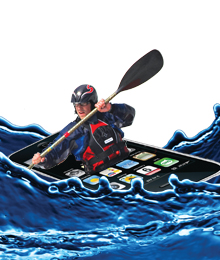Digital Technology Trends
February 10, 2011 by Michael Hill
Filed under lifestyle
 As we plunge into the unknown expanses of the future, we must navigate the always-changing waters of the digital sea. Growing and multiplying at an ever-accelerating rate, technology is constantly evolving in both looks and functionality. There was a time when technology changed infrequently – a time when typewriters were used for typing, cameras took pictures and calculators calculated. But ever since the introduction of the consumer computer, technology has increased its pace, leaving consumers adrift in the wake of obsolete devices, software and formats.
As we plunge into the unknown expanses of the future, we must navigate the always-changing waters of the digital sea. Growing and multiplying at an ever-accelerating rate, technology is constantly evolving in both looks and functionality. There was a time when technology changed infrequently – a time when typewriters were used for typing, cameras took pictures and calculators calculated. But ever since the introduction of the consumer computer, technology has increased its pace, leaving consumers adrift in the wake of obsolete devices, software and formats.
It’s no secret that technology is always on the move. Devices and hardware we once thought to be ideal, important and perhaps even “cool” eventually become obsolete. We’ve recently seen this through pagers, fax machines, physical maps, VCRs and more recently, DVDs. With the popularity of Facebook, who even prints photos anymore? But these are obvious examples. With the increasing availability and decreasing cost of smartphones, tablets and other WiFi-enabled devices (which now include videogame consoles, Blu-ray players and TVs), what other common devices will soon be phased out?
“I think physical media,” explains tech expert Marc Saltzman. “The idea that you have to rent or buy something on a piece of plastic, like a videogame or a movie, is going the way of the Dodo Bird, and quicker than we think.”
As a journalist, author and TV/radio host, Saltzman is a leading Canadian expert on consumer technology. Although physical media is in decline, Saltzman is hesitant to say it is obsolete. “I wouldn’t say obsolete, but right now we’re starting to see digital sales creeping up. I think over the next couple of years it will eclipse traditional paper sales.”
Saltzman’s view of the future is certainly accurate, and we only need to look at consumer’s consumption habits to see why: CD sales are down while digital downloading of music continues upwards; Blockbuster filed for bankruptcy in the U.S. while on-demand, digital streaming services like Netflix expanded; sales of e-Reader devices, like the Kobo and Kindle, are constantly growing; and BitTorrent, an online company specializing in software that makes it easier to transfer large files over the Internet, hit 100 million members in 2010. With the increasing power and decreasing size of computers, the digitization of media and information is the way we’re headed.
For Saltzman, this is part of the second stage in the evolution of consumer electronics. The first being products dedicated to a single task, like printers, early cellphones and cameras. “The second major trend was when we saw convergent devices – one product that did multiple things. All-in-one printer, scanner, copy, fax machines with memory card readers. And then, smartphones that let you check your e-mails, chat via IM or text messages, surf the web, play games, navigate city streets, listen to music, watch movies, take pictures – it became this all-in-one device,” explains Saltzman.
With so much media and information accessible for smartphones and tablets, and their various functions, we are entering the third major step in consumer technology’s evolution: connectivity. “I’m a firm believer that in a couple of years we’re going to have multiple tablets laying around our homes; sub $100 devices that are all connected wirelessly that let you read e-mail, surf the web and access your media … that’s where I think we’re going,” explains Saltzman.
Imagine the power to control the world around you with a single device: start your stove from the office while it constantly keeps your tablet informed of its temperature; wirelessly turn off the lights if you forget to do so; or even stream movies, music or other media from your hard drive at home (or some other source) while on a long road trip. In fact, much of this technology already exists, although not quite in the mainstream (for example, Bell TV’s Remote PVR feature).
Saltzman predicts – which I believe to be correct – that we will start to see “ecosystems” of technology form around us, all communicating, supplementing and complementing each other. But what happens when these systems break down? How do I access my media when my computer stops working or that format stops being supported (just like VHS tapes)? What happens when 100 years from now a historian picks up a CD and can’t access what’s on it? Unlike physical media such as books, printed music or stone tablets, digital information is under constant threat of deletion, hard drive crashes and format changes. Just think about that computer you had 10 years ago; where is it now? Physical media may one day become obsolete, but its durable attributes will see it last longer than that photo album on your Mac. As consumers, all we can do is
stay the course and navigate the choppy waters of the ever-changing digital sea.







Comments
Feel free to leave a comment...
and oh, if you want a pic to show with your comment, go get a gravatar!